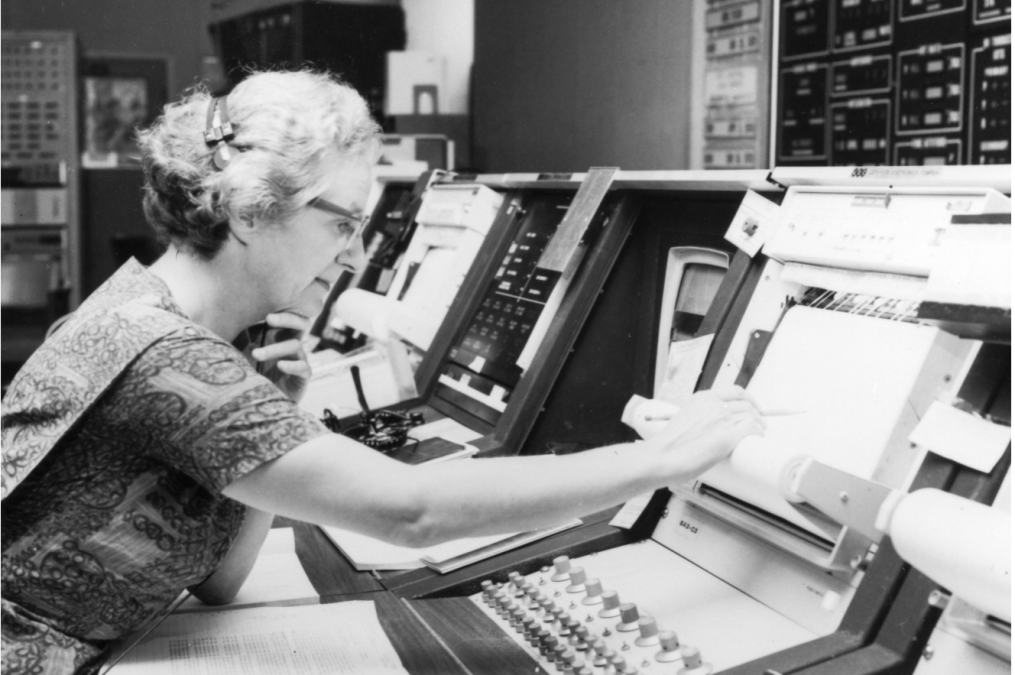by
_____
As a girl in Michigan, she would go out after dark with her mother to watch the constellations, and she fell in love with the night sky. But her high school counselor told her the natural sciences weren’t appropriate for young women — she should study the humanities instead.
Fortunately she ignored that advice.
At Swarthmore College, the Dean of Women was “very opposed to women going into science or engineering,” Roman later recalled, “so opposed that if she couldn’t talk a girl out of it, she just never had anything more to do with her for the four years she was there,.”
But she was determined — and got her PhD from the University of Chicago.
She went on to become the chief of astronomy in the NASA space program, helping to design and produce nearly all the orbiting observatories launched in the 1970s and 1980s, and leading a team of scientist to build the Hubble Space Telescope.
Part of Roman’s role was to travel around the country, giving talks to academics in astronomy departments about the work at NASA, and educating her audiences about the advantages of observation from space.
At key points in her career, public speaking played a central role in her success.
Last week, NASA announced that its newest space telescope would be named for Nancy Grace Roman — the first female executive at NASA who also served as the agency’s first Chief of Astronomy.
It’s the first time in NASA’s history that one of its giant, billion-dollar programs has been named for a woman.
Roman’s trailblazing academic and research career was focused on microwave spectrography and radio orbiting observatories. Because of her advocacy for space-based observation, she’s known as “the Mother of Hubble.”
But throughout her career, Roman faced gender stereotyping and discrimination that relegated women in science to secondary roles. When she received her PhD in astronomy from the University of Chicago in 1949, it was nearly impossible for a woman to get tenure in any academic astronomy research department.
She went on to study galactic structures in the radio astronomy branch at the Naval Research Laboratory (NRL) in Washington DC, where work was underway in a new area that held grate promise — radio astronomy.
Earlier, as a young researcher at McDonald Observatory in West Texas, Roman had noticed unusual features in a star and published her findings in The Astrophysical Journal. That led to an invitation to a 1956 conference on non-stable stars, held to celebrate the opening of an observatory on Mount Aragats in Armenia, then in the Soviet Union.
Roman was among the prominent scientists gathered there, making her the first US civilian to travel to the Soviet Union at the start of the Cold War. She was only 31 years old.
She visited several spots in the USSR — including another observatory at Abastumani in Western Georgia.
When she got back to the US, she was invited to give a colloquium on her experiences behind the Iron Curtain — a series of ten lectures to engineers and scientists.
That boosted her reputation. Officials at the newly-formed National Aeronautics and Space Administration (NASA) took note and in 1959 hired her to set up their first program in space astronomy.
“My job was to try to build support for the space science program in the US astronomical community.”
Her prominence led to a number of newspaper profiles. As she noted in an interview in 2000: “When I joined NASA . . . because the women’s pages were so very anxious to get material, I got a great deal of publicity.”
Typical was one in 1959 in which the reporter described her as “an attractive brownette.” The writer noted that Roman was “evidence that ‘looks and books’ do go together. She is a well-built 5’5″, with fine, regular features. Her flawless complexion is accented by eyes of a color that defies description.”
Still, the visibility became an advantage — and opened doors.
In the years before JFK expanded the space program, public enthusiasm for space research and exploration was low. Even many in the scientific community thought the things NASA was trying to accomplish in space could be better done from the ground.
Part of Roman’s role was to travel around the country, giving talks to academics in astronomy departments about the work at NASA, and educating her audiences about the advantages of observation from space.
“What I sort of saw as my job in that area was to try to build support for the space science program in the US astronomical community,” she said in a 1980 interview. “I tried to swing opinion from what I would say was overwhelmingly hostile in 1959 to tolerance and finally support.”
Throughout 1960s, she was one of NASA’s most popular public speakers on “The Role of Women Scientists in the Space Program.” She referred to herself and other female scientists in her talks and encouraged young women to study the natural sciences — the opposite of how she herself had been treated.
“It’s important to inspire girls and let them know that they can go into science and other technical fields,” she said.
The Nancy Grace Roman Space Telescope, which will launch in the mid-2020s, will explore long-standing astronomical mysteries, such as the dark energy that is speeding up the expansion of the universe, and search for distant planets beyond the solar system.
Female astronomers who look up to Roman will be able to look up in the night sky and find inspiration in her telescope.
© Copyright 2020
________________________________
Want to talk? Reach me at dana@danarubin.com



